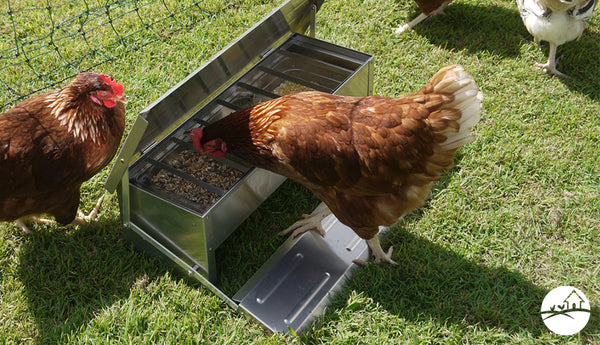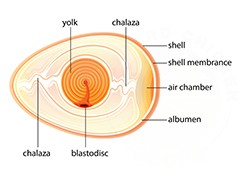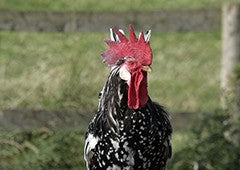Once upon a time, chickens were wild creatures, running around in their native habitat and scratching and foraging for food. So before they could pop down to the shop and buy themselves some lay mash, what on earth did the wild chickens eat for food?
What on earth do you mean - ‘wild chicken’?
Firstly, what do we mean by ‘wild chicken’? Well, one of the first recognisable breeds of wild chicken was the ‘Jungle Fowl’. This breed is pretty much the foundation of all chicken breeds we know and love today! The Jungle Fowl can still be found in the wild in places like Indonesia, India and Southeast Asia. You can also find them in Australia, however they are not running loose - many people continue to breed them for their spectacular colours. So when we refer to the ‘wild chickens’ that make up our domesticated chickens ancestors, think of the Jungle Fowl!
Many chicken keepers ask this question because they want to replicate the chickens natural diet rather than give them commercial feed. Well, before the chickens were fed their daily scraps at 5pm from their keepers, their diet was made up of a number of different food sources. Well, if you’re interested in bringing your chickens diet back to that of their fore bearers (within reason) and finding out what chickens eat in the wild, here’s a guide to the food of the fowls of old!
Crunchy, juicy, tasty insects! A smorgasbord for wild chickens
Insects found from foraging were the staple of the wild chickens diet. Termites, ants, even grasshoppers are rich in protein and nutrients, and very tasty for our little chickens! Another delicious treat that a scratching, foraging chicken would also come across is a big, fat, juicy worm! Mmm...worms are another great source of protein for active chickens, to help keep them healthy.
Should I still feed these to my chickens?
Modern domesticated chickens that free range still enjoy the tasty benefits of insects, as they peck them up off the ground and out of our precious garden beds. A pest-free garden is quite the benefit for the avid gardener! Chickens can also enjoy tasty meal worms as a treat, but give it to them in small quantities as too much protein is not good for them. Can you imagine if the wild chickens got given a handful of meal worms without working for it? They would have gone, well, wild!
Wild chickens got their leafy green fix from natures plants
Before there was home-grown garden produce to peck at, chickens got their natural nutrient fixes from edible plants growing around their environment. They also loved to peck at wild berries and fruits that were within the reach of their beak (no wonder they still love berries so much!). Leaves from young plants rounded out their all natural diet.
Should I still feed these to my chickens?
It’s still a great idea to feed your domesticated chickens some fresh produce and plant-based foods to keep their nutrients up. Spinach, kale, cabbage, and also things like pumpkin and potato will help keep your chickens healthy and full. Fresh or frozen berries are also still a poultry favourite in our backyard flocks, and very nutritious and delicious for them - so keep on feeding! Maybe you can scatter them around the backyard so the chickens can behave like their wild ancestors and ‘forage’ for berries. Nothing gives them incentive to exercise like food!
Pretty much anything they can get their beaks on....
Nowadays, the few ‘wild chickens’ that still exist pretty much eat any human food they can get their beaks on. Hey, you gotta survive how you gotta survive! This means some wild birds have eaten all sorts of crazy food - popcorn, white bread, when they’re desperate, they’ll eat anything they can get their beaks on!
Should I still feed these to my chickens?
Chickens can eat some human food like cooked rice, pasta, bits of whole grain bread, and of course fresh leafy greens, fruits and veggies - but when it comes to things like popcorn (we mean the stuff laden in butter and salt) it’s probably best to steer clear! Chickens won’t be able to digest junk food or processed food very well (plus it’s not very good for them!) so it’s probably best to leave these in the rubbish. Also, anything high in sugar should not be fed to the flock, as it’s not great for their digestive system. No lollipops for the girls!
So if you’re looking to give your girls the authentic diet of their wild chicken ancestors, and have been pondering what chickens eat in the wild, it’s all about insects, worms, leafy greens and berries! (It’s kind of like the ‘paleo diet’ for chickens!). It’s still recommended that you keep feeding your girls lay mash, as this has been specifically formulated to their needs and has the right levels of nutrients required. You can always give the chickens the natural treats of their ancestors as a side dish!
With so many options available when feeding your flock, it can be overwhelming! Many health issues experienced by our girls are due to an imbalanced diet. So, when preparing nutritious mealtimes for optimal chicken health, you might find yourself asking: what to feed, when to feed, how to feed, and why?!
Cluckily, our friends at Chickenpedia can help you find out what’s best for your flock at all ages. This is why I recommend their Feeding Pecking Chickens Course to all my readers. Through their course, unearth nutrient-rich foods to help your chickens stay healthy, live longer, and produce the best eggs. Keep those yolks nice and yellow! The course shares advice and information on the best food for your flock as well as quantity control, storage, and timing for feeds.
Feeding time is also a great one for entertainment and this course provides bonus content filled with DIY boredom busters, toys, and treats for your flock. Become an eggspert and gain the confidence needed to choose the right chicken feed and know which ones to avoid.
Be sure to click here to visit Chickenpedia today to check out ALL of their amazing courses.




















